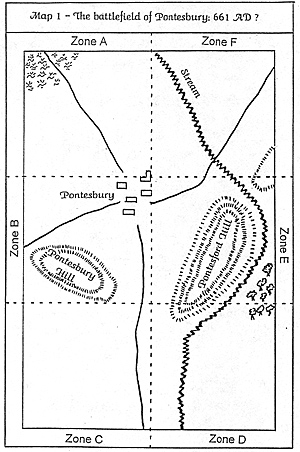 In my refight the Shropshire army deployed roughly north-south just to the east of Pontesbury using the southern hillfort as their camp. The Welsh then appeared in zone "B" to the west of the village at midday. The two force were quickly in combat with light troops securing their northern flanks in the village and the cavalry on their southern flanks vying for control of Pontesbury Hill.
In my refight the Shropshire army deployed roughly north-south just to the east of Pontesbury using the southern hillfort as their camp. The Welsh then appeared in zone "B" to the west of the village at midday. The two force were quickly in combat with light troops securing their northern flanks in the village and the cavalry on their southern flanks vying for control of Pontesbury Hill.
Almost at the same time (end of turn 2) Cenwalh arrived with the men of Wessex in zone D. Things were looking bad for the Shropshire army. However, the Wessex forces were obviously tired after force marching to meet their allies. (They threw a series of "1s" and "2s" for movement). This, combined with the sodden ground following an extended wet spell, meant it was several hours before they were able to deploy to support their allies. (The stream was found to require dicing to cross by each unit, most of whom needed several attempts). Well this did supposedly take place at Easter and March/April can be pretty wet.
In the meantime the Shropshire men, fighting on home ground, had secured the village. Their cavalry totally outclassed the Welsh horse, then swept down the hill to start rolling up the main Welsh battle line. Within two hours the Welsh army was shattered. The would-be Prince and his bodyguard spotting the approach of Wulfhere’s Mercians decided discretion was the better part of valour.
While the Shropshire men finished the rout of the Welsh, the two Saxon forces squared off in a roughly east/west line from Pontesford Hill to Pontesbury Hill. Things swayed to and fro here for some time. The Mercians with the advantage of the slope gradually pushed back both flanks. Then the victorious Shropshire cavalry reappeared, with their infantry somewhat behind. Just as the west wing of the Wessex army broke in rout, a last ditch charge lead by Cenwalh himself broke Wulfheres Hearth troops. It was late afternoon. The two sides drew apart unable to continue. Wessex had failed in its bid to wrest Shropshire from Mercian control. The remaining Wessex forces were badly outnumbered and demoralised, but Mercia was stunned by the loss of its king.
Postscript
The astute amongst you will have noticed the title of this article. Sadly, modern place name authorities do not generally identify the Anglo-Saxon "Posentbyrig" with Pontesbury. They also don't identify where it is.
Local tradition about a battle may be the result of the folklore collectors themselves. The earliest collectors believing the battle was at Pontesbury, asked the locals if they knew about a battle, but discovered nothing. The next collectors found such a story in existence. Doubtless the more stories you had to tell, the more pints it was worth down at the local when the folklorists came round again.
The context of the battle makes it more likely a straight head to head between Wessex and Mercia somewhere along the Thames valley with a pursuit to the same Ashdown near Reading where Alfred fought in 871 (or possibly Ashdown Forest in East Sussex. After all, later in the same year the chronicles tell us that "Wulfhere ravaged the Isle of Wight" which is more likely if the earlier battle was fought on the Wessex/Mercian border than on the Welsh border.
So overall, my interpretation of Posentbyrig is perhaps unlikely, but not impossible, and probably a more valid alternative history than many wargames. I also think it is just that bit more interesting than two mid Saxon period armies slogging it out over some indeterminate tract of Dark Age countryside. I didn't need to consult any hard-to-obtain texts or obscure tomes and if I can do it, so can you. No doubt "proper" historians will throw up their hands in horror. But I had fun on the way. And that's the whole idea, isn't it?
References
[1] Shropshire Hill Country; Vincent Waite. Pub Philimore. ISBN 0 85033 365 2
[2] The Anglo-Saxon Chronicles; translated by Anne Savage. Pub Book Club Associates.
[3] Anglo-Saxon England; Sir Frank Stenton (Oxford History of England). Oxford University Press; ISBN 0 19 821716 1
[4] Various county history book including volumes of the “Victoria County History,” available for many counties.
[5] King Arthur: The true story, Phillips and Keatman. Pub Arrow. ISBN 0-09-929861-0
Readable interpretation of post Roman Shropshire, whether or not you accept the "Arthurian" connection.
Footnote
As is often the way whilst completing this article I came across another possible reference to the battle. This suggested that the site was at Posbury, near Crediton in Devon. I don't know if there is other evidence except the name. I am not afraid to admit this makes it more likely I am wrong but I still had a good game. In any case the history was incidental to a certain degree. What I was more concerned to illustrate was the sort of processes and mechanisms that can be used to recreate the battle of your choice.
The Devon option is potentially a whole new (war)game. Does the Chronicle entry imply Wulfhere devastated the Wessex heartlands while Cenwalh was campaigning against the Britons of Dumnonia on his Western borders? Answers in one thousand words, including suggestions for a full campaign to Lone Warrior please.
More Pontesbury 661AD
Back to Table of Contents -- Lone Warrior #139
Back to Lone Warrior List of Issues
Back to MagWeb Magazine List
© Copyright 2002 by Solo Wargamers Association.
This article appears in MagWeb (Magazine Web) on the Internet World Wide Web.
Other military history articles and gaming articles are available at http://www.magweb.com
